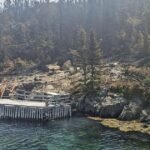A wall of flames advancing at unprecedented speed has forced the complete evacuation of Morley’s Siding, Newfoundland, as provincial officials battle what they describe as “extreme and unpredictable wildfire behavior” unlike anything witnessed in recent years. The rapidly deteriorating situation prompted authorities to declare a state of emergency late Tuesday, with residents given mere hours to gather essential belongings and flee to safety.
“We’re facing fire behavior that’s outpacing our predictive models,” said Jeff Motty, Provincial Fire Duty Officer with the Forestry Department. “The combination of unusually dry conditions, strong winds, and accumulated forest fuel has created a perfect storm scenario that’s challenging even our most experienced firefighting teams.”
The wildfire, which has already consumed over 3,500 hectares of dense forest, doubled in size within just 36 hours according to CO24 News tracking data. Satellite imagery reveals a concerning pattern of rapid expansion toward populated areas, despite aggressive aerial suppression efforts.
Provincial emergency services have established evacuation centers in Grand Falls-Windsor and Gander, with approximately 230 residents registering for assistance. The Canadian Red Cross has mobilized additional resources to support displaced families, many of whom left with little more than the clothes on their backs.
“It was chaos,” described Sarah Thornhill, a 15-year resident of Morley’s Siding. “The sky turned this eerie orange color, then the smoke became so thick you couldn’t see across the street. When the evacuation order came, we had 90 minutes to decide what to take from a lifetime of memories.”
The provincial government has activated its emergency coordination center, bringing together resources from multiple agencies including forestry services, the RCMP, and local emergency management teams. Premier Andrew Furey addressed the situation during an emergency press conference yesterday, pledging “all available provincial resources” to combat the fires and support affected communities.
“We’re monitoring this situation minute by minute,” Furey stated. “Public safety remains our absolute priority, and we’re working closely with Canada’s federal emergency management partners to ensure we have every resource needed to protect our communities.”
Climate scientists from Memorial University have noted that Newfoundland is experiencing increasingly severe wildfire conditions due to climate change effects. Dr. Eleanor Ripley, a climatologist specializing in Atlantic Canada weather patterns, told CO24 that the province is witnessing “a fundamental shift in its fire regime.”
“What we’re seeing matches global patterns of increased wildfire intensity in regions previously considered low-risk,” Dr. Ripley explained. “Newfoundland’s traditionally wet, cool climate is changing, creating longer dry periods and more favorable conditions for extreme fire behavior.”
According to CO24 Business analysis, the economic impact extends beyond immediate property damage. The region’s forestry sector, tourism operations, and transportation infrastructure face significant disruption, with initial damage estimates exceeding $25 million.
Provincial officials have requested assistance from the Canadian Armed Forces, with water bombers from Quebec and New Brunswick already deployed to the area. Environment Canada has issued special air quality advisories for communities across central Newfoundland as smoke plumes drift eastward.
As climate change continues altering fire patterns across Canada, how will traditionally low-risk regions like Newfoundland adapt their emergency response systems to meet these new, more dangerous wildfire realities?










